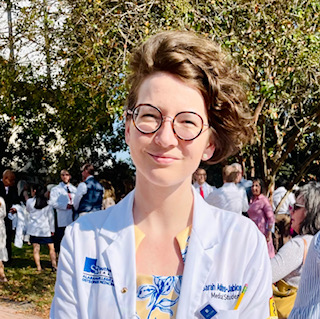
Corporate Member Spotlight: Alabama College of Osteopathic Medicine
WMA is generously supported in part by the regional business community through its corporate member program. For this spotlight, we talked with Sarah Adkins-Jablonsky, a student at the Alabama College of Osteopathic Medicine about the connections between art and medicine. Southeast Health and ACOM both support WMA as a Patron level corporate member.

Sarah Adkins-Jablonsky, ACOM student, museum volunteer, and artist
WMA: Sarah, you’re an ACOM student, an active volunteer at WMA, and an artist yourself, so you stay busy. What would you like people in our region to know about ACOM students?
Sarah: Something that I think is really cool about students at ACOM – as a community of people who are on average in their late 20s – is that we are very culturally diverse, and I think that brings a lot of new experiences and conversations to the Dothan area. In my friend group, there are people practicing all different religions, with families who come from all different countries, and even within the Southeast area, there are a lot of students from Florida, Alabama, and Georgia who represent intersections of the region. When we go out to the community, we share our cultures and our stories, and in exchange, we learn about people in Dothan. We all made our way to ACOM in Dothan for a reason, and it’s to learn from and alongside the people here.
WMA: What drew you to ACOM?
Sarah: I want to be a family physician in the Navy, and I really like that ACOM was built to fill the deficit of family physicians here in Alabama. When deciding on a school model that could fill the family doctor deficit, the founders decided on making an osteopathic/DO rather than allopathic/MD medical school because DO schools tend to teach through the lens of of hands-on personable family medicine, although they also teach for students to enter a variety of medical specialties. I appreciate how that need inspired so much of their curriculum, and I also like that it’s a D.O. school, so its philosophy focuses on how medicine can heal the body, with an understanding of the body’s innate ability to heal itself. We also learn about osteopathic manipulative treatments as a part of our toolbox of ways to treat patients, and that’s what I was really interested in.
WMA: You’re the President of ACOM’s Arts in Medicine Club. Will you tell us more about what this student organization does?
Sarah: Since its creation there have been lots of students with backgrounds in visual and performing arts but just last year, a group of these students came together and founded the Arts in Medicine Club at ACOM. This year, we were able to take it a step further and make it an organization, which makes us eligible for funding so that we can carry out our events. We have over 100 students that are members, and the thing we’re most excited about is continuing the relationship established last year with you all at the Wiregrass Museum of Art. We’re excited to help spread the word about your events, and we also have an ACOM student talent show happening at Write Night: Open Mic Night really soon, so we’ll see students really expressing ourselves. In the future, we’re excited about what it might look like for this club to have volunteer opportunities in the hospital and clinical spaces, so that we’re not just helping ourselves as medical students, but we’re also helping the patient population through art.
WMA: What do you hope to see in the future for the intersection of art and medicine?
Sarah: I would really like it if every medical school had an Arts in Medicine course. I was able to audit the special elective Arts in Medicine course at the UAB Heersink School of Medicine a couple of years ago. What was really cool about that class is that you learn observational skills through the practice of looking at art slowly and deeply, and we’re able to translate those skills into patient care, when we’re looking at patients. I think that really fits into the osteopathic model of medicine, where we’re trying to spend more time with patients. Building observational skills through the lens of arts in medicine is another contextual basis that will serve us well indefinitely. I’d also like to see more opportunities for research to grow in this area, in having more randomized controlled trials in arts in medicine research.
WMA: Sarah, thank you so much for sharing your experiences as a student with us today – we’re so glad to have ACOM students’ vibrant presence at the museum and in the Wiregrass region. Is there anything else you’d like to share with our members?
Sarah: I am a member of Ground Floor Contemporary in Birmingham, Alabama, and one of the first times I visited WMA, I saw works by a lot of Ground Floor Contemporary artists that I personally know, like Sara Garden Armstrong, and professors at UAB. It was the first time that I had seen works from these people outside of the city that I knew them from. That felt, personally, very meaningful, to see what it means to be an Alabama artist. I’m not originally from Alabama, and moving here, I had a lot of biases about what people would be like, and what conversations would be like, but seeing that spectrum of people who are now Alabama artists, like Doug Baulos, and my mentors in the art world, gave me a sense of home and place here. Their works are so diverse and reflect their life experiences, and it was one of the coolest things to make those connections at WMA.
To learn more about how your company or organization can support WMA’s mission, contact Melissa Rea at 334-794-3871 or mrea@wiregrassmuseum.org.
View More Stories